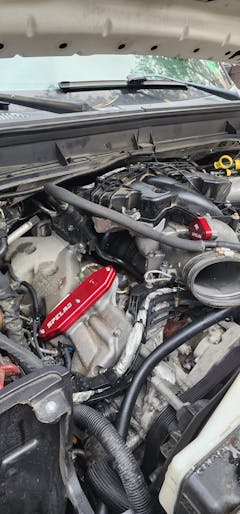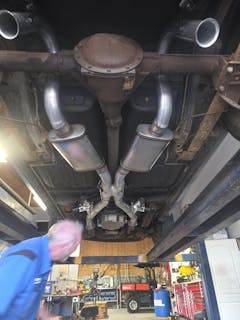12 Products
CCV PCV Reroute Kit
1. What is the CCV system for diesel trucks?
For diesel truck owners, understanding the factory Crankcase Ventilation (CCV) system is essential to maintain performance, reduce emissions, and avoid long-term damage.
Whether you own a 2020 Ford F250 6.7 Powerstroke or a 2017 Chevrolet Silverado 3500HD with a 6.6L Duramax L5P, the CCV system plays a key role in managing engine pressure and controlling oil vapor from crankcase blow-by gases.
Let’s take a closer look at the major components of a factory (OEM) CCV system:
1.1 CCV Filter
The CCV filter captures oil mist and microscopic particles from the crankcase gases. On trucks like the 6.7 Cummins (2019 RAM 2500), this filter is mounted on top of the valve cover and needs to be replaced every 67,500 miles to maintain efficiency and prevent oil saturation.
1.2 Oil Separator
Found in models such as the 2015 Ford F350 6.7L Powerstroke, the oil separator is often built into the valve cover. It uses baffles or mesh to physically separate oil droplets from gases. The oil drains back to the oil pan, while cleaned vapors continue into the intake.
1.3 CCV Valve / Pressure Control Valve
Also known as the PCV valve, this part regulates crankcase pressure. In engines like the 6.0 Powerstroke, the CCV valve helps prevent excess pressure that could cause oil leaks, or too much vacuum that can draw contaminants into the system.
1.4 Ventilation Hoses
These connect the crankcase, filter, and intake system. In the 2016 Ford F250 6.7 Powerstroke, the hose routing is engineered to move filtered vapors back to the turbo inlet, maintaining a closed system to comply with EPA emissions standards.
Although the CCV system is designed with emissions and pressure control in mind, it can become a liability over time. Diesel truck owners often face problems like clogged CCV filters, oil build-up in the intake, and reduced performance. That’s why many eventually choose to upgrade or bypass the system using a CCV delete kit or reroute solution.
2. Why Should You Upgrade or Delete Your CCV System?
Over time, the factory CCV system on diesel trucks like the 6.7 Cummins, 6.0 Powerstroke, or 6.6L Duramax often becomes a source of performance inefficiencies and maintenance headaches.
2.1 How a 6.7 Cummins CCV Filter Causes Intake Oil Build-Up and Pressure Issues
The primary purpose of the OEM CCV system is to control crankcase pressure and redirect blow-by gases—including oil vapor—back into the intake system to meet emissions standards. However, this process introduces several long-term issues that make a strong case for upgrading or deleting the system altogether.
As oil vapors cycle through the intake, they gradually accumulate along the intercooler piping, intake valves, MAP and IAT sensors, and even the turbocharger. This oil film reduces intake efficiency, raises exhaust gas temperatures, and contributes to carbon buildup, especially in engines equipped with EGR systems.
The CCV filter itself becomes saturated over time—especially in models like the 6.7 Cummins, which requires filter replacement roughly every 67,500 miles—leading to increased crankcase pressure, oil seepage from gaskets, and even compromised turbo seals.
2.2 A CCV Delete Kit Eliminates Oil Recirculation
Replacing the OEM system with a CCV delete kit or CCV reroute kit removes the oil vapor loop entirely. Instead of recycling oil-laden gases, these kits reroute or vent the crankcase through a sealed catch can or breather, capturing contaminants before they reach the intake.
This modification significantly reduces the risk of oil pooling in the intercooler, minimizes sensor fouling, and improves air-fuel efficiency. On average, catch cans in a CCV delete system can collect between 3–6 ounces of oil every 3,000 miles, depending on driving conditions and engine wear.
The result is a cleaner intake tract, improved combustion efficiency, fewer emissions-related maintenance issues, and a more stable crankcase pressure environment. For performance builds or high-mileage trucks, the long-term gains in engine cleanliness, reduced EGTs, and component longevity make a CCV delete a highly practical upgrade.
3. What’s Included in a CCV Delete Kit, and What OEM Parts Does It Replace?
Upgrading to a CCV delete kit isn’t just about adding an aftermarket component—it’s about completely replacing and improving several factory-installed parts. These kits are designed to simplify the crankcase ventilation system, reduce maintenance, and eliminate the downsides of recirculated oil vapor.
Here’s a breakdown of what you typically get in a quality CCV delete kit—and which OEM components they’re designed to replace:
3.1 CCV Delete Kit Components
Most SPELAB CCV delete kits (including for the 2011–2024 Ford 6.7 Powerstroke and 2017–2024 L5P Duramax) include the following parts:
-
Billet CCV cover or sealed plate
Replaces the factory CCV filter housing or valve cover vent port. -
Catch can with internal baffling (optional in some kits)
Collects oil mist from blow-by gases before they exit the system. -
Reinforced silicone or braided ventilation hoses
Routes gases to a new exit point, often via atmosphere or catch can. -
Mounting hardware and brackets
For secure installation of the catch can and rerouted hose system. -
Breather or filter element
Allows pressure release to atmosphere in open systems, where permitted.
3.2 OEM Parts Replaced or Bypassed
| OEM Part | Replaced by CCV Delete Kit |
|---|---|
| CCV Filter (e.g., CV52001 on 6.7 Cummins) | Billet block-off plate or external breather system |
| Oil Separator / Valve Cover Vent | Rerouted hose and/or sealed canister |
| CCV Hoses / Recirculation Tubing | High-flow aftermarket ventilation hose |
| PCV Valve / Pressure Control Valve | Breather or atmospheric vent (open systems) |
Depending on your engine—such as the 2008–2010 Ford 6.4L Powerstroke—some components are fully integrated into the valve cover, requiring the delete kit to bypass the entire OEM configuration through external routing and block-off elements.
4. CCV Delete/ CCV Upgrade Kit Pros And Cons
A CCV delete kit or CCV upgrade system is more than just a hardware swap—it's a targeted solution designed to resolve long-term issues caused by the stock crankcase ventilation system on diesel trucks like the 6.7 Cummins, 6.6L Duramax, and 6.0 Powerstroke.
4.1 Pros: Why It’s a Smart Upgrade
1. Stops Oil Contamination in the Intake System
The factory CCV system routes oil-laden blow-by gases back into the intake. Over time, this results in oil buildup in the intercooler piping, turbocharger, and intake valves. Deleting or rerouting this system eliminates this contamination, especially on trucks like the 2017 RAM 2500 6.7 Cummins, where oil pooling inside the intercooler is a common issue.
2. Prevents Crankcase Overpressure
Saturated OEM CCV filters—like the one used on the 6.7 Cummins CV52001—can cause internal pressure to rise. This leads to oil seepage from seals and potential turbo damage. A CCV delete stabilizes crankcase pressure, reducing wear on internal components.
3. Simplifies Maintenance
No more replacing filters every 67,500 miles. Instead, catch can-equipped systems just need occasional draining. On average, a catch can on a 2019 Ford 6.7 Powerstroke captures 3–6 ounces of oil every 3,000–5,000 miles, depending on driving style and engine wear.
4. Improves Combustion and Airflow
By eliminating oil vapor from the intake, combustion becomes more efficient. Users report improved throttle response, reduced EGTs, and more stable boost levels—especially in tuned setups or heavy towing conditions.
5. Cleaner Engine Bay, Fewer Emissions-Related Issues
Less oil circulating through the intake means cleaner sensors (MAP, IAT), fewer carbon deposits, and lower chances of triggering check engine lights due to oily residue.
4.2 Cons: What You Should Be Aware Of
1. Not Legal for On-Road Use in All States
In some regions, deleting any emissions-related equipment—including CCV systems—is not road legal. These kits are typically intended for off-road or race applications only.
2. Installation May Require Moderate Mechanical Knowledge
Depending on your engine—such as the 2008–2010 Ford 6.4L Powerstroke—some installs involve removing valve cover vents or rerouting hoses in tight engine bays. While bolt-on, it’s not always beginner-friendly.
3. Catch Can Maintenance Still Required
Though filter replacements are eliminated, catch cans still need to be checked and drained regularly to avoid overflow and pressure issues.
SPELAB testing and customer data have shown that properly installed CCV delete kits can eliminate up to 100% of intake oil contamination, lower exhaust gas temperatures under load, and help extend turbo and EGR component life. For high-mileage diesel owners or performance-focused builds, the tradeoff is overwhelmingly in favor of the upgrade.
5. CCV Delete Kit Fitment Guide: Powerstroke, Cummins & Duramax
Before purchasing a CCV delete kit, it's essential to verify that the system is compatible with your specific truck model, engine configuration, and production year. SPELAB offers a wide range of CCV delete and upgrade kits engineered to fit the most popular diesel platforms, including 6.7 Cummins, 6.0 & 6.4 Powerstroke, and LML/L5P Duramax engines.
Here’s a comprehensive fitment guide to help you find the right kit for your truck:
5.1 Supported Vehicle engines
| Make / Engine | Model Years | Fitment Notes |
|---|---|---|
| 6.7L Cummins (Dodge/RAM) | 2010–2024 | Fits RAM 2500/3500; replaces CV52001 CCV filter |
| 6.7L Powerstroke (Ford) | 2011–2024 | Compatible with F250, F350, F450 Super Duty platforms |
| 6.4L Powerstroke (Ford) | 2008–2010 | CCV vent port removal may require valve cover access |
| 6.6L Duramax LML | 2011–2016 | Fits Silverado/Sierra 2500HD & 3500HD |
| 6.6L Duramax L5P | 2017–2024 | For use with updated intake routing and ECU-safe reroute paths |
5.2 Kit Compatibility Tips
-
6.7 Cummins CCV filter change is straightforward with SPELAB kits, which eliminate the need to replace the CV52001 filter and allow for catch-can installation or breather reroute.
-
2011+ Ford 6.7 Powerstroke CCV delete kits are often bolt-on and require minimal modification, with direct fitment to OEM locations.
-
6.4 Powerstroke owners may need to access the valve cover for proper block-off installation, due to the integrated design of the factory oil separator.
-
For Duramax L5P models, verify whether your intake routing has been modified or tuned, as certain catch can placements may vary by application.
6. How to Install a 6.0 Powerstroke CCV Reroute Kit
If you're running a 2003–2007 Ford F250 or F350 Super Duty with the 6.0L Powerstroke, installing a CCV reroute kit is a smart upgrade to reduce oil vapor recirculation, protect your turbocharger, and keep your intake system cleaner. Unlike the more complex CCV systems on newer trucks, the 6.0 Powerstroke uses a simpler crankcase vent system that dumps blow-by gases directly into the intake tract before the turbo—leading to oily intercooler piping, carbon buildup, and reduced performance over time.
The good news? Installing a 6.0 Powerstroke CCV reroute kit is straightforward and can be done with basic tools in under two hours.
6.1 Estimated Installation Time and Cost
-
Time required: 1 to 1.5 hours
-
Tools needed: Flathead screwdriver, socket set (8mm/10mm), hose cutter, pliers
-
DIY cost: ~$60–$120 depending on the kit style (open breather or catch can)
6.2 Installation Steps (2003–2007 Ford 6.0 Powerstroke)
Step 1: Locate the CCV Vent Tube
Pop the hood and remove the engine cover. You'll find the stock CCV vent hose connected to the passenger-side valve cover and routed into the intake tube leading to the turbo.
Step 2: Disconnect and Remove the OEM Hose
Use pliers or a flathead screwdriver to loosen the hose clamps. Remove the OEM breather hose from the valve cover and intake.
Step 3: Plug or Cap the Intake Port
Install the rubber or billet plug included in the SPELAB CCV reroute kit to seal off the port on the intake tube. This prevents unfiltered air from entering the turbo once the reroute is complete.
Step 4: Install the Reroute Hose or Breather Filter
Attach the included reroute hose to the valve cover port and either route it downward toward the frame (for open venting) or connect it to a catch can system if your kit includes one. Secure the hose with clamps.
Step 5: Mount the Catch Can (Optional)
If you're using a 6.0 Powerstroke CCV reroute kit with catch can, mount it on the firewall or inner fender. Ensure it’s upright and easily accessible for draining.
Step 6: Double Check and Test
Start the engine and let it idle for 5–10 minutes. Watch for any signs of oil leaks, pressure buildup, or abnormal engine noise. Confirm that the new breather path is venting correctly.
6.3 Notes for This Model
-
The 6.0L Powerstroke CCV system is simpler than newer platforms, making rerouting an easy upgrade even for DIY users.
-
Make sure to check local regulations if venting to atmosphere, as open systems may not be emissions compliant.
-
Adding a small breather filter to the end of the reroute hose helps prevent dust from entering in rare reverse-flow situations.
-
No tune or calibration is needed after installing the CCV reroute kit.
7. Other Supporting Parts (Beyond the CCV Delete Kit)
In addition to CCV delete kits, this product collection page also includes several supporting components that enhance system reliability, improve cooling efficiency, or address known weak points in diesel platforms like the 6.7L Powerstroke, 6.4L Powerstroke, and 6.6L Duramax. These parts are often installed alongside or in preparation for a CCV system upgrade.
Here’s a quick breakdown of what else is offered:
7.1 Coolant Bypass Kit
A popular add-on for trucks like the 2017–2024 L5P Duramax Silverado 2500 HD, this kit helps reduce coolant pressure on the rear cylinders, where hotspots typically occur. It provides a secondary return path for coolant, improving heat distribution and helping protect head gaskets under heavy load or towing.
7.2 Coolant Hose Barb Adapter Leaking Repair Kit
Specific to platforms where coolant hose barbs are prone to leaking—such as the 2008–2010 Ford 6.4L Powerstroke—this kit provides a reliable replacement to eliminate coolant seepage, particularly around aging plastic fittings or corroded metal joints. Often used as a preventative upgrade during cooling system overhauls.
7.3 CCV Delete Kit + Catch Can Internal
Some kits on this page bundle an internal baffled catch can with the CCV delete system, offering superior oil vapor separation. These are especially useful for 2011–2024 Ford F250 6.7L Powerstroke owners who want to avoid rerouting vapor to atmosphere and maintain a cleaner, more closed-loop design.
7.4 Use Case Integration
All of these products are fully compatible with SPELAB’s core CCV delete solutions and are frequently purchased together to create a more reliable, longer-lasting engine system. Whether you’re deleting the CCV, replacing worn hoses, or improving coolant circulation, these additional parts offer excellent synergy.
8. Top 5 CCV Combo Recommendations
For diesel owners who are serious about performance, longevity, and reducing maintenance headaches, pairing a CCV delete kit with other key upgrades can unlock even more value.
Here are five proven CCV upgrade combos recommended by the SPELAB team and trusted by diesel enthusiasts:
8.1 CCV Delete Kit + EGR Delete Kit
Why it works:
Both the CCV and EGR systems contribute to intake contamination. Oil mist from the CCV and carbon from the EGR mix into thick deposits on your intake valves and sensors.
Benefits:
-
Up to 95% reduction in intake buildup
-
Lower exhaust gas temperatures
-
Smoother throttle response
Best for: Heavy towing, high-mileage diesels
8.2 CCV Delete + ECU Tuner
Why it works:
Deleting the CCV system allows for cleaner airflow. Pairing that with a tune optimizes fuel delivery and boost management.
Benefits:
-
More horsepower and torque
-
Better turbo spool-up
-
Reduced soot generation in closed systems
Best for: Tuned daily drivers or weekend builds
8.3 CCV Delete + Upgraded Intake Elbow
Why it works:
Once the CCV system stops contaminating the intake, upgrading the elbow further increases clean air delivery.
Benefits:
-
Improved airflow efficiency
-
Cooler intake temps
-
Cleaner combustion
Best for: Any truck using a catch can or open breather system
8.4 CCV Delete + Catch Can + High-Flow Air Filter
Why it works:
Catch cans separate oil mist, while a high-flow air filter ensures that only clean air enters the engine.
Benefits:
-
Nearly 100% oil vapor removal
-
Improved filtration over OEM systems
-
Less sensor fouling
Best for: 6.7 Cummins and 6.7 Powerstroke platforms with frequent stop-start driving
8.5 CCV Delete + Coolant Bypass Kit
Why it works:
As you push your engine harder, managing both air and coolant is key. This combo improves pressure regulation and temperature balance.
Benefits:
-
Reduced rear-cylinder hotspots
-
Protects head gaskets
-
Balanced coolant flow
Best for: Long-haul, lifted trucks or tuned builds in hot climates
9.CCV Delete Kit FAQ
Q1: Is a CCV delete kit legal for street use?
A: In most U.S. states, CCV delete kits are considered emissions-related modifications and are not legal for on-road use. These kits are intended for off-road, competition, or race-use vehicles only. Always check local and federal emissions regulations before installing.
Q2: What happens if I don’t replace my CCV filter?
A: A saturated CCV filter can lead to increased crankcase pressure, oil leaks, and possible damage to turbo seals or gaskets. On the 6.7 Cummins, the factory filter (CV52001) is recommended to be replaced every ~67,500 miles. A CCV delete kit eliminates this ongoing maintenance cost.
Q3: Do I need to retune my truck after installing a CCV delete?
A: No tuning is required for most CCV delete kits, including those for 2020 RAM 2500 6.7 Cummins and 2015 Ford F250 6.7 Powerstroke. However, pairing it with a tune can enhance engine response and optimize airflow, especially if combined with intake or EGR modifications.
Q4: Will a CCV delete kit improve fuel economy or performance?
A: While a CCV delete won't increase horsepower by itself, it reduces intake restriction and lowers oil contamination, resulting in more efficient combustion. This can lead to smoother throttle response, better turbo efficiency, and potential fuel economy gains, especially under load.
Q5: How do I know if my truck is compatible?
A: SPELAB CCV delete kits are designed for specific diesel platforms including:
-
2011–2024 Ford F250/F350/F450 (6.7L Powerstroke)
-
2010–2024 RAM 2500/3500 (6.7L Cummins)
-
2008–2010 Ford Super Duty (6.4L Powerstroke)
-
2011–2024 Chevy Silverado / GMC Sierra 2500HD & 3500HD (LML / L5P Duramax)
Check the product title or fitment chart to confirm compatibility with your vehicle’s year, model, and engine.
Q6: Do I need a catch can or just a breather?
A: It depends on your driving conditions and local laws.
-
Catch cans are ideal for daily drivers and tuned trucks because they capture and store blow-by oil.
-
Breather filters are easier to install and better for off-road or race setups where vapor can safely vent to atmosphere.
Q7: Will I need to drain the catch can often?
A: On average, expect to drain 3–6 ounces of oil every 3,000–5,000 miles depending on engine health and load. A visual inspection every oil change is typically enough. SPELAB catch cans include easy-access drain valves for convenience.
Q8: Can I do a CCV delete on a 7.3 Powerstroke?
A: Yes, the 7.3 Powerstroke (especially 1999–2003 models) can benefit from a CCV mod or delete, though it’s more commonly referred to as a CCV reroute on this platform. The stock system vents crankcase gases into the intake tube just before the turbo. By rerouting it to atmosphere or a catch can, you can prevent oil from entering the turbo and intercooler system. This is a popular and cost-effective upgrade among 7.3L owners.
Q9: What’s the difference between a CCV reroute and a full delete on Powerstroke engines?
A: A CCV reroute typically redirects blow-by gases to a new location—usually atmosphere or a catch can—while keeping the factory breather components intact. A full CCV delete, like those available for the 6.7 Powerstroke, replaces or bypasses the OEM filter, separator, and recirculation hoses completely. The choice depends on how much you want to simplify the system and whether you need to stay emissions compliant.
Q10: Is there a specific CCV delete kit for the 6.7 Powerstroke?
A: Yes. SPELAB offers a 6.7 Powerstroke CCV delete kit designed for 2011–2024 Ford Super Duty models (F250/F350/F450). These kits replace the factory separator system and include billet adapters, hoses, and optional catch cans. Installation is typically bolt-on and does not require tuning, but always confirm your engine configuration and local emissions laws before modifying.
Filter products
- ENGINE
-
POWERSTROKE
- DPF Delete Exhaust
- All In One Kit
- EGR Delete Kit
- CCV PCV Reroute Kit
- DPF Delete Dual Exhaust
- Tuner
- Intercooler Pipe Kit
- Up-Pipe
- Intercooler
- CP4 Bypass Kit
- CCV Recirculating Kit
- Muffler
- Downpipe
- Intake Manifold
- Air Intake Kit
- Radiator
- Oil Catch Can
- Differential Cover
- Valve Cover
- Transmission Pan
- Coolant Expansion Tank
- Exhaust Manifold
- Turbo
- Fuel Tank Sump Kit
- Fuel Injector Tool Kit
- Tonneau Cover
- DURAMAX
- DODGE RAM
- ALL-IN-ONE KITS
- CATEGORIES
-
-20%

-
-27%

-

-

-
-7%

-

-

-
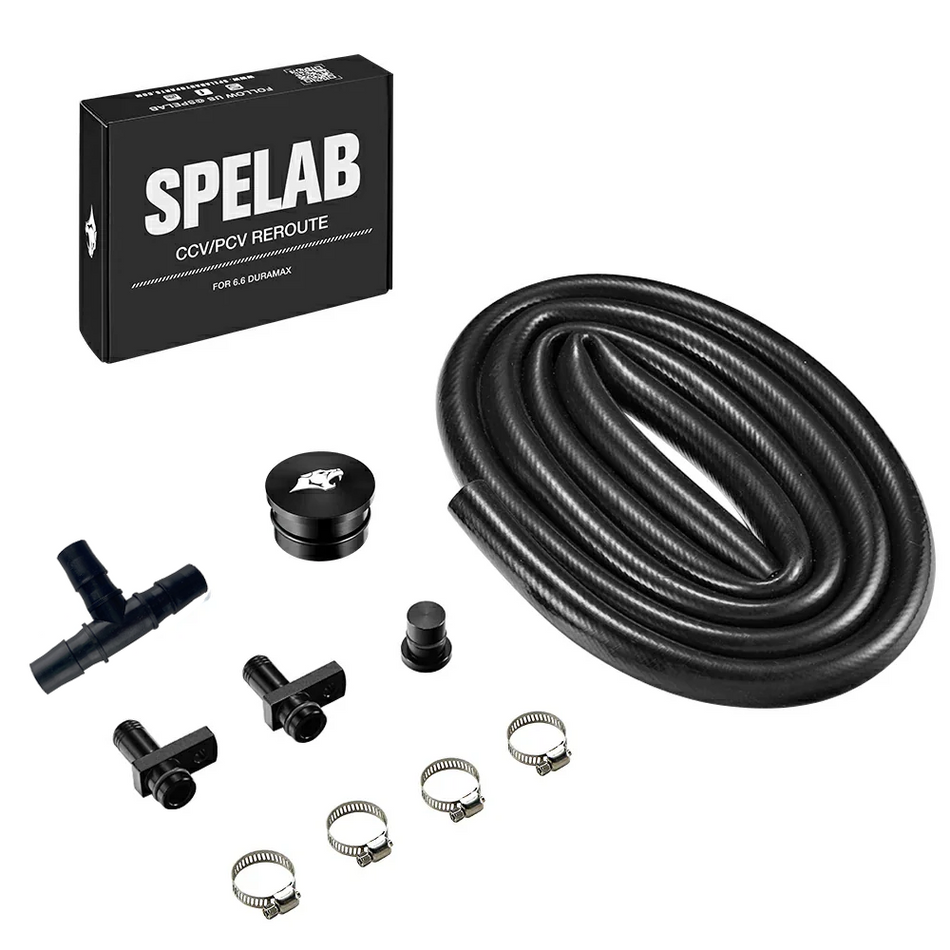
-

-

-


-
 44 reviews4.84 44 reviewsRegular price From $36.90
44 reviews4.84 44 reviewsRegular price From $36.90Fitment:
2011-2019 Ram 2500 3500 4500 5500
2009-2010 Dodge Ram 2500 3500 4500 5500
Let customers speak for us
from 3954 reviews
Purchased a ccv reroute kit. It was easy to install, fits well, quality parts. I plan on using this company for my EGR delete also. The power stroke kit comes with everything needed. I highly recommend.

Ccv reroute for the l5p needs revision but absolutely will work good parts

Very nice features and great quality at a very reasonable price!
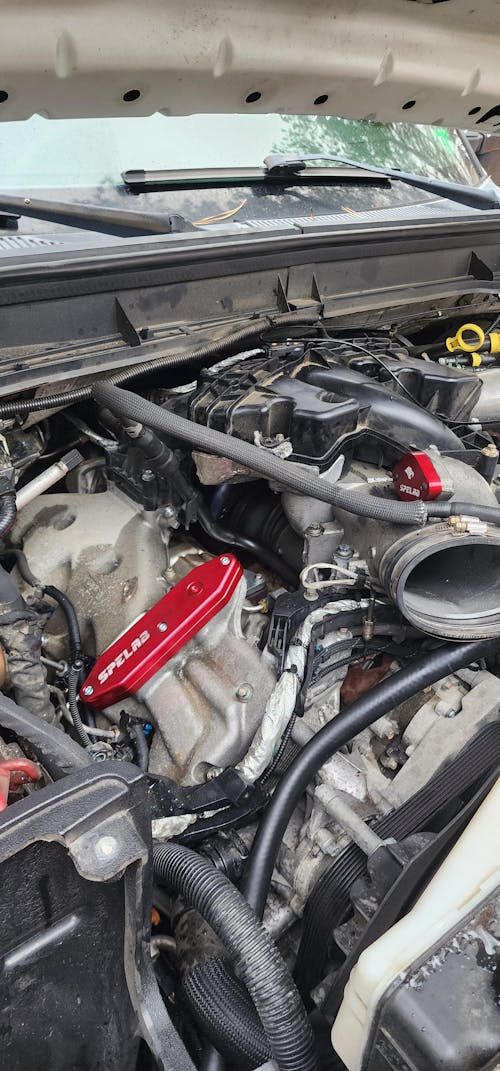
Very well made product
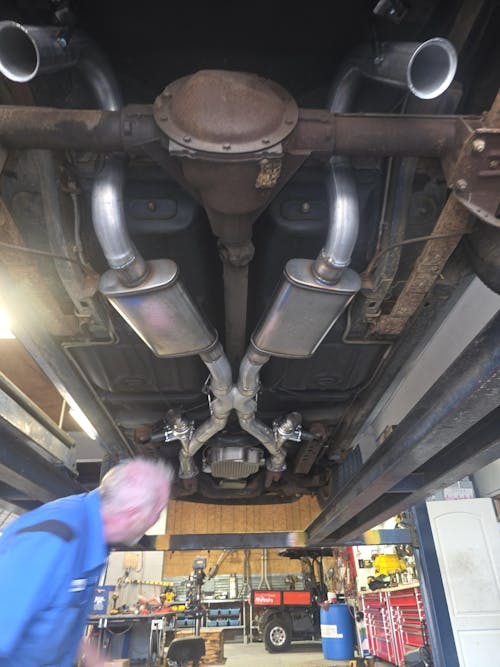
Awesome product I put the 3" cutouts on my 78 nova and they work great. Easy to install.
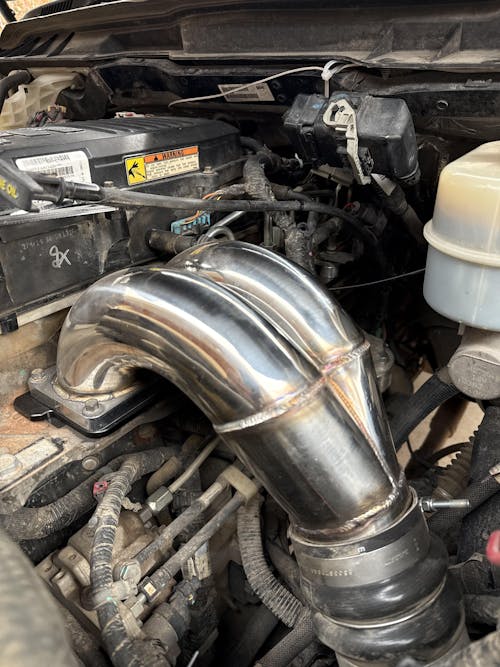
After installing the Spelab intake my EGT’s have lowered about 150/200 degrees from stock! I tow 90% of the time with this truck, I should have done this upgrade way earlier!
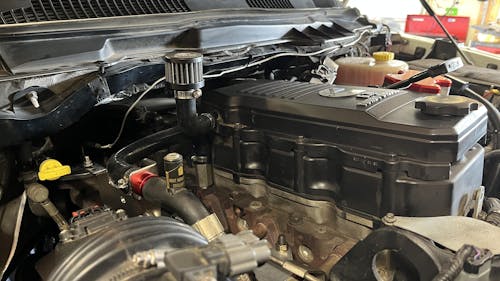
This kit came in a very nice box with all the necessary hardware to complete the installation without any modifications. Installation time was about two hours working methodically by myself with some occasional help from my 13 year old son as he passed through the garage. As many others have commented it would be nice to have some printed instructions with the kit, but it is not hard to figure out. I went with the red version because it was the cheapest, and I think it looks great. After installation, custom tuning with a mm3 tuner, and an upgraded exhaust the 6.7 is opened up and free to run.
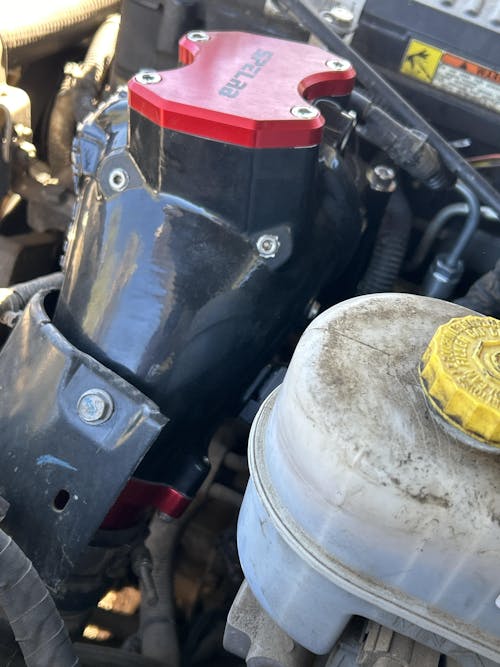
Great components solid workmanship very happy with the product and looks really rood. I went with the red
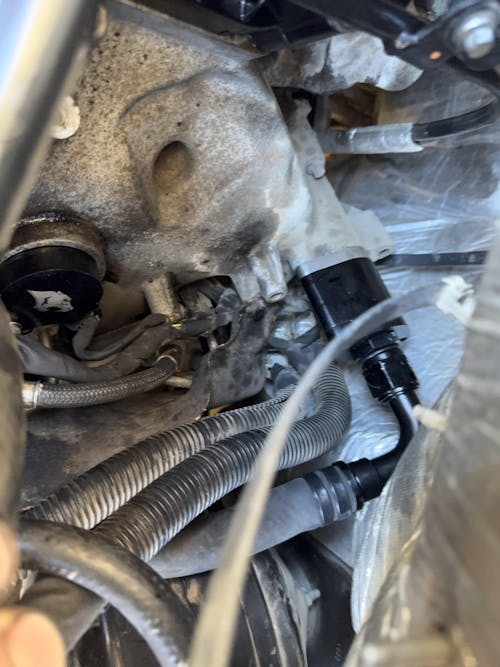
I am a mechanic so it’s hard for me to say someone with absolutely no skills that this is easy. But watch YouTube I will say everyone is worried about the egr exhaust bolts. But one video he sprayed them and soak them. I had sprayed mine each time I drove the truck and every morning for 4 days. Than another video a guy said drive the truck get it hot than when you go to take them out hit the socket and extension with hammer to loosen them. So I also did this. They all came out with absolutely no problem. I did have to take off my intake cause I did the ccv and disaster kit as well. And these bolts did not get sprayed. And one did break! I was able to get it out with wd40 and pb blaster and tapping with hammer. To drop dpf I sprayed the hangers with pb blaster used a pry bar and they pop right off. Remember when taking that off you might miss a coupe connectors so take your time! Also the back of dpf I had two broken studs and one so rusted that I had to use a grinder. After got it out I had to take a drill to my existing manifold cause the rusted bolts closed up the holes. Currently I left my dpf tank in the truck. I plan on removing it but I don’t have a reason yes!
Make sure to read all instructions and again take your time. I’m currently having issues updating the mini max cause I didn’t do it before install. But spe hands down was amazing the products everything was perfect besides the intake. The mass air flow sensor didn’t fit and to clean the metal shavings I used brake clean and it melted there spray paint on that one product, everything else i believe is powder coated. I know it’s not part of this kit but the cp4 disaster kit make sure you tighten hose clamps I did not do this and it cam off so I had to take upper and lower intake off on the side of the road and lucky the truck didn’t burn down. But I would say that was my fault for not verifying!

Fits great! Easy install! All parts come with this as well didn’t need to go out and get anything. Not only that but the price man that’s damn good
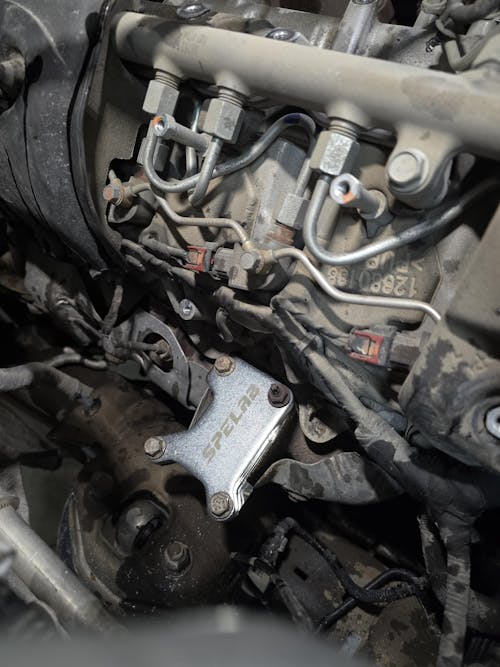
Good fitment on all items. All block off plates fit good and dont leak. Downpipe fits perfectly. All gaskets included good quality.
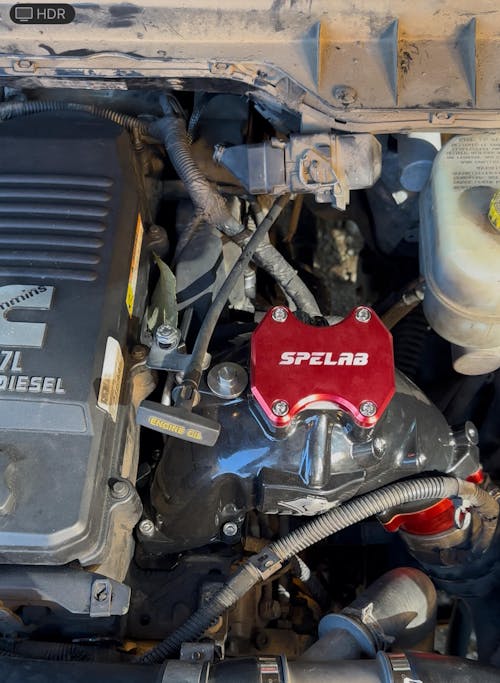
I’m so happy with my egr delete kit and intake. I made the best decision in choosing Spelab to enhance my 2500 ram truck. I’ll keep buying more stuff from them. It’s starting to be an addiction!! Thanks Spelab!!
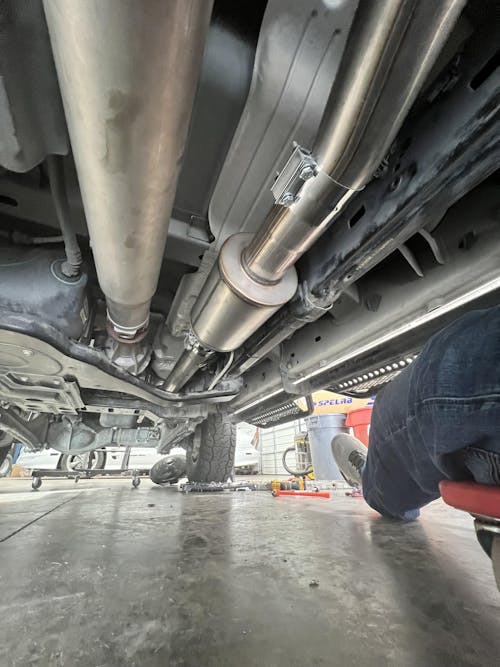
The exhaust and muffler fit great. Had to make one cut but that took no more than a couple minutes to measure and make the cut. I’m very pleased with the muffler included, sounds good but keeps the noise down and no drone in the cab. Will buy again.
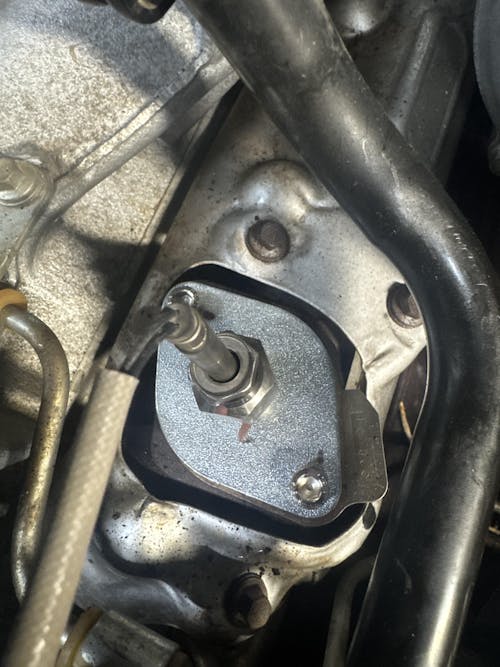
Everything fit great. The finish is good and it includes everything you need to get rid of that POs Egr cooler
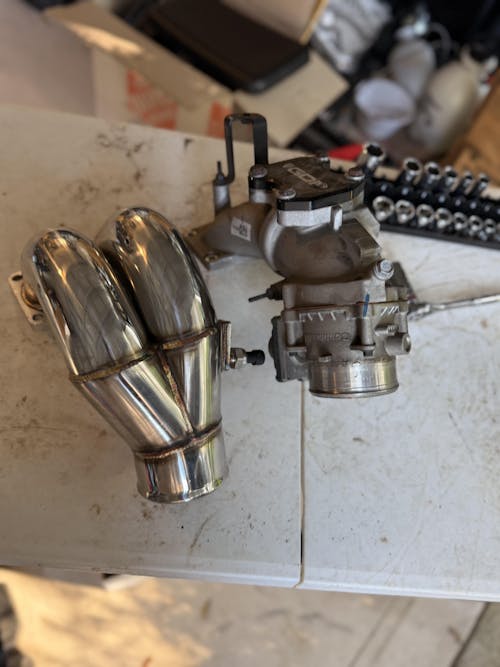
You know how it goes when you try to save a dollar, you cut cost of quality. But this is actually not the case so far. Finish is smooth, no bad cuts that i could see. Plate wasn’t warped with was a concern for me but no leaks this far. I’d buy again

















